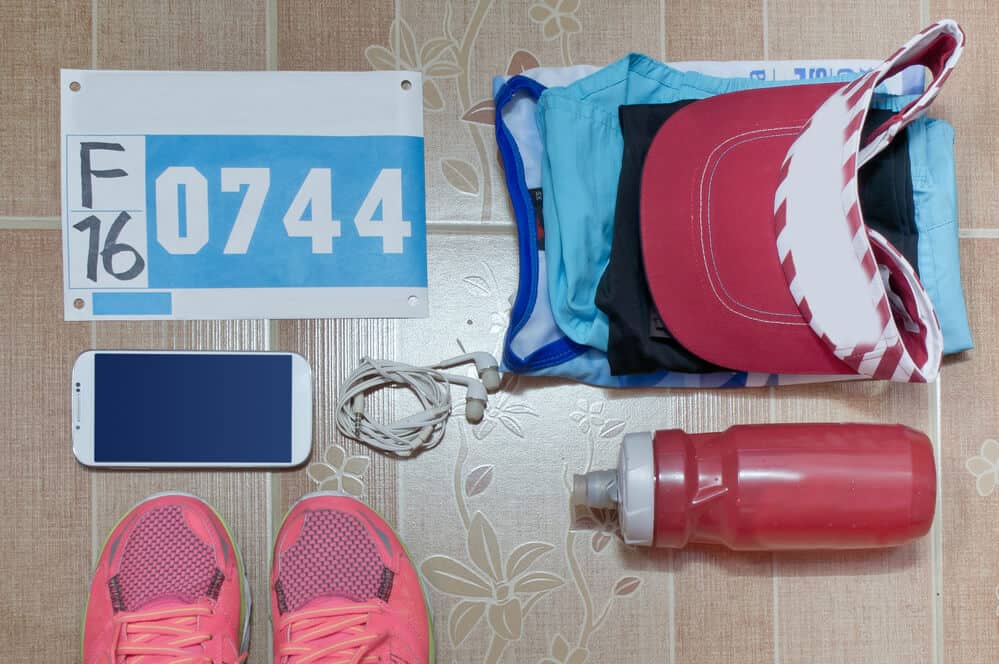Comparable to a marathon or a half marathon, a 5k isn’t that long. It covers 3.1 miles, which shouldn’t be a big deal for a professional runner.
For beginners, though, it’s a whole different story. To be able to run a 5k without feeling like your lungs will pop out of place-now that’s a real challenge!
No worries, though; if you have 16 weeks, you have plenty of time to train and prepare yourself. The duration is even enough to train for a whole marathon.
Having run my share of 5k races, I know what you should and shouldn’t do. In this guide, you’ll find everything you need to know.
How to Prepare for a 5k in 16 Weeks
Four months preparing for a 5k is plenty of time. You have time to try on different shoes, build your muscles, and practice a lot. Here are the detailed steps for your preparation phase.
Step 1: Invest in Running Gear

Chances are, you already have most of your running gear ready in your wardrobe. But in case you don’t, here are the items you’ll need:
- Shoes
- T-shirt
- Shorts
- Socks
Females will need a sports bra in addition to those. Besides, if we’re in the summer, you may need an extra pair of running sunglasses for the sun.
If you love accessories, you can grab a couple of those too. For example, some runners invest in running bands to keep their phones out of the way. Meanwhile, others get reflective bands for running at night.
I, for one, believe that your shoes are your most essential gear. If the shoes are bad, they’ll reflect on your whole running workout. You want to grab a comfortable pair that are tight enough not to slip out but loose enough not to cut off the blood flow.
They should also have foam or gel soles for the utmost comfort and for shock absorption.
If you’re setting a budget for your running gear, be generous with the shoes’ share. A runner with a bad running shoe is like a golfer with a bad club.
Step 2: Learn the Right Way to Run
If you’re a beginner runner, there’s a high chance you’re running incorrectly. Running may seem like it’s easy, but there are some guidelines that you need to follow to run properly. Otherwise, you may be prone to spine and neck injuries.
For example, your shoulders should be straight and lean back rather than forward. Your chest should also be directed up, with your arms going back and forth in a straight line. Bear in mind that your arms shouldn’t go across your body.
Aside from that, your hips should be directly above your feet when you’re running, so your body stays balanced.
Step 3: Create Your 5k Training Plan
Since you have a 16 week duration to prepare, you should create a training plan. Otherwise, you won’t keep track of your progress.
Along the training plan, you should upgrade your mileage, speed, and endurance with each week. There are multiple ready-to-print plans available, but I’ve always believed it’s better to create your own plan.
In the end, you’re well aware of your fitness level, and you can create a plan to align with your skills.
I’ll go into creating the plan later, but for general guidelines, here’s what each week should look like:
- Monday: An easy run (You should upgrade from half a mile to 4 miles in the 16 weeks)
- Tuesday: Rest (In later weeks, you can do endurance or cross training)
- Wednesday: Interval training/long runs/hill repeats (You should increase the intensity as you go forward)
- Thursday: Rest
- Friday: Same as Wednesday
- Saturday: Rest (In later weeks, change it to quick walks or easy runs)
- Sunday: Long run (Start with 2 miles and go up to 6 miles)
Step 4: Stretch Every Day

Stretching is an integral part of your 5k training plan. In fact, even if it’s your rest day of the week, you can get up and stretch some muscles.
Stretching doesn’t only help your muscles recover after exercising, but it also reduces post-exercise soreness. On top of that, it reduces the risk of developing injuries.
Here are the muscles you should focus on stretching before and after your running workout.
Quads
It goes without saying that you should stretch the quads after running. In most warming up and cooling down routines, you’ll find a fair share for the quads alone.
These muscles form the front and sides of your thighs. Running helps them grow stronger, but they’re prone to getting pulled or injured. So, make sure to stretch them regularly.
Hamstrings
While the quads form the front and sides of your thighs, the hamstrings are at the back of your thighs. They’re equally important, and they contribute to your knee flexion motion. Every time you stretch the quads, make sure to stretch the hamstrings as well.
Calves
The calves extend from your ankles up, precisely behind your shin bone. They go in the back of your legs.
If you haven’t noticed that already, the calves and shins are always the first muscles to hurt when you’re running. That tells you a lot about their importance.
Try to stretch them both before and after your running exercise.
Step 5: Start Endurance Training

If you don’t know anything about endurance training, now is the time to learn.
When you build your endurance, your body is more capable of sustaining a workout for a long duration. There are two main types of endurance: muscular and cardiovascular.
Muscular endurance is your muscles’ ability to work for long hours without getting tired. Meanwhile, cardiovascular endurance is your lungs’ ability to keep supplying oxygen sufficiently for an extended period.
Endurance training is often aerobic exercise that lasts for an extended period to build both your stamina and endurance. The exercising options are endless, ranging from brisk walking and jogging to biking and swimming.
Since you have enough time to prepare, it’s good to include endurance training in your plan. That way, you can finish your 5k race easily at a reasonable pace.
Step 6: Eat Well and Sleep Enough
When you have an upcoming event with physical activity, you need to have enough nutrition and sleep. Running workouts aren’t the only thing you need for a 5k race; you also need to eat right and sleep enough.
By enough, I mean at least 5-8 hours each day. We all have different sleeping schedules, depending on our bodily needs. So, you can sleep as much as you need, but don’t sleep less than five hours a night.
As for nutrition, the topic is quite controversial. For some odd reason, it’s widely believed that runners should focus on carbs, carbs, and carbs only. While carbs are important, you need protein and fat too.
Carbs are responsible for giving you energy, protein is responsible for growing and repairing your muscles, and fat is mainly responsible for nerve function.
A runner’s diet should be a balanced mix of these three nutrients. The majority of your diet should be fruits and veggies, with sufficient amounts of protein and fat.
Don’t get too excited, though. I don’t mean fat as in greasy-burger-and-fries fat. I mean the healthy fats in avocados, nuts, and peanut butter.
Step 7: Rest When You Need
Nobody got too far by pushing their bodies too hard. It’s true, you have to feel pain in order to grow muscles and build your stamina, but that pain is different from I-need-rest-now pain.
If you keep pushing through the pain, you may end up with an injury or an exhausted body. In the first phase of your training plan, try to learn your limits. Know what you’re capable of and what you can’t do just yet.
Then, work on getting there gradually without pushing your body over the edge.
When you’re too tired to run or exercise, that’s your cue to rest. Your body is telling you that it needs rest, and you stubborning your way through it isn’t going to help.
If you need an extra day of rest in your plan, don’t hesitate to take it. And learn to listen to your body when it’s in pain. After exercising, you should be feeling regular soreness and muscle burning. If the pain is beyond that, it’s time to rest.
Step 7: Register for the Race
It’s better to start looking for a race to register as early as possible. Some people start looking three months before they’re ready, but I’d say two months is enough to find a spot in your favorite race.
Make sure to consider your needs before registering for the race. For one, make sure it’s in your town or at least nearby. In addition to that, choose the theme you want; some races are charity-themed. If you want to participate in something like that, it’d be wise to consider when looking.
Step 8: Ease Your Pre-Race Anxiety
No matter how long you have to prepare for your race, you’ll always feel anxious. Some people feel the anxiety kick in one month before the race day, and the majority of runners experience it only a few days before the big day.
You’ll encounter negative thoughts and jitters, and these are completely normal. To deal with them, keep your eyes on the goal.
You don’t need to be the first to cross the line, and you don’t need to do it while feeling fresh. The achievement here is crossing the line, no matter how exhausted, shriveled, or slow you are.
There are also a couple of tips to help with these pre-race jitters:
- Familiarize yourself with the racecourse a couple of weeks before the race day
- Create running mantras in your head or look them up online to help you stay motivated
- Visit online running communities and share your fears; you’ll find that everyone is pretty much feeling the same
How to Prepare for a 5k in 16 Weeks – Training Plan
Since you’ll be creating your training plan yourself, you may need some help. Without some guidance, you may not know how the mileage upgrades should go and how frequently you need to rest.
Here are detailed steps to help you:
Step 1: Start With Walking
The first week or two of your training plan should have more walking than running. Make sure to include at least three repetitions of 20-minute quick walks.
To upgrade to running, start including short joggings bursts. For example, walk for 20 minutes then jog for three or five minutes in the end.
Step 2: Run Short Distances Every Other Day
For the first few weeks of your training plan, run short distances at least three times a week. By short, I mean a mile or less. If you’re more familiar with time intervals rather than distance intervals, you can calculate using time instead. For example, run for 10 minutes rather than for half a mile.
Don’t run this short distance every day; have a day of rest or cross-training in between, and try to improve your pace as you go on.
Step 3: Include Cross-Training
As you advance with your plan, include cross training on some of the rest days. It can be anything, such as swimming, cycling, or even weight lifting.
Step 4: Increase the Running Time Gradually
From week six to week nine of the training plan, you should work on increasing your running time and pace for the short run. If you run 10 minutes, work on getting to 30 minutes in the span of these four weeks.
Step 5: Run Longer on Later Weeks
When you’ve been running short distances for some time, you can start increasing your running distance. Start with half a mile on the first week, and work on getting it to four miles by the last week.
Final Thoughts On How to Prepare for a 5k in 16 Weeks
Running a 5k is always more fun than preparing for it. The pre-race anxiety is sometimes too hard to handle, but keeping your eyes on your goal ought to do it. You have more than enough time to prepare and go on with your training plan, so there is no need to worry!
